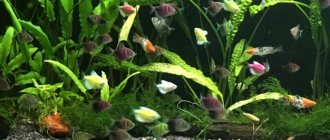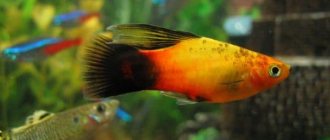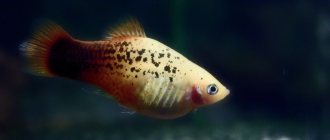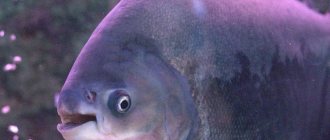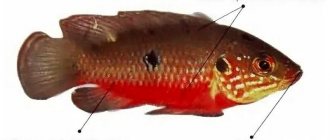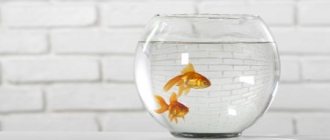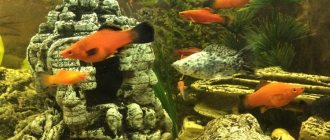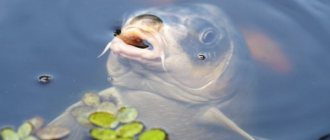Those who decide to have an aquarium at home most often start with peaceful and small fish. It is believed that they are unpretentious and can withstand the tests that inexperienced aquarists will prepare for them. Pecilia is one of these fish. She is not demanding, small and not pugnacious. And how many color options for these aquarium fish there are! Having created heavenly conditions for their life, you can admire these wonderful inhabitants for a long time.
General information
Pecilia (Xiphophorus maculatus) is a viviparous fish, which, according to the new classification, has been transferred from the genus Pecilia to the genus Swordtails. This species appeared in Europe in the 20th century, and was first described in 1886.
Individuals move moderately quickly, smoothly, without jerking or twitching. They feed variedly - they eat algae, insects, and small invertebrates without shells. In an aquarium, platies live from 3 to 5 years.
Platies are peaceful fish that get along well with other types of fish.
Interesting Facts
- Platies of all types can live in both fresh and salt water.
- The female platie has the ability to change her sex and grow gonopodium. This happens if the conditions of detention are not met.
- If platies live in the same aquarium with swordtails, individuals of these species easily interbreed. But this ultimately ends in the degeneration of the platies.
Appearance
In nature, platies are not particularly decorative; their color is quite modest. Thanks to the work of breeders, aquarium platies have acquired a wide variety of colors. In nature, fish reach 18 cm, and in an aquarium they grow to a maximum of 5 cm.
Features of the appearance of platies:
- body shape - short, diamond-shaped;
- caudal fin wide;
- the head is proportional in size to the body;
- eyes - large;
- color - pale yellow, with brown splashes.
Habitat of platies
The natural habitat of platies is water bodies in Central America (Guatemala, Mexico) and the southern part of North America (US states of Florida, California, Colorado). This is a freshwater fish, but it has also managed to adapt to life in water with high salinity. Therefore, it can be found at the mouths of rivers that flow into the Atlantic Ocean. Fish prefer areas of biotopes with muddy soil and dense thickets of plants. The habitat of the most attractive individuals in appearance is the Yucatan Peninsula.
Popular types of platies
Breeders have bred about 30 varieties of platies, and over 120 color options. Next are the fish that are most popular among aquarists.
White
This is a rare fish, since its color is not always inherited from its parents. There is no coloration due to the switching off of the genes responsible for pigmentation. The fish is almost transparent - through its scales you can see the insides of its abdomen.
Neon (rainbow)
The fish is not as rare as the white variety, but it is rarely found on sale. This fish has a pleasant blue or bluish tint, and its scales glow with an unusual neon glow.
Hawaiian
This fish's color is predominantly black and yellow. Moreover, all Hawaiian platies have a red tail. The fins are yellow or transparent.
High fin
Breeders obtained this fish by crossing platies with flag swordtails. Its peculiarity is a large, highly protruding fin on its back. The coloring is different.
Black
These fish, despite their name, are not completely black in color. Black color is combined mainly with red and orange shades. The fins and tail are light and translucent.
Red
These fish have a pure red body color. The fins are also colored in reddish shades, but they are also translucent.
Individuals with black fins are not red platies. These are fish of a different species.
Mickey Mouse
This platie received its unusual name for its design, associated with a stylized image of the cartoon mouse Mickey Mouse. It is located in the back, caudal part of the body. The drawing consists of three circles, of which the large one is the head, two small ones are the ears.
The coloring of Mickey Mouse is the most diverse - there are yellowish individuals, red, bluish, with a combination of several shades.
Radish
This original fish was bred fifty years ago, and its main feature is the caudal fin. It has a diamond shape, with a stripe in the central part. The coloration is varied, but a completely red body with a black tail is considered a classic.
Tricolor
This fish has a combined coloration. Moreover, there are different combinations - there are individuals whose blue color is combined with yellow and green. Other fish have black combined with orange and yellow.
The colors of tricolor platies are distributed completely unpredictably, with no clear boundaries. This fish likes to hide in dense thickets.
Balloon
The peculiarity of this fish is its unusual, spherical shape, which distinguishes the balloon from all other platies. She has a large, ugly protruding abdomen and a short body with a curved spine. Cylinders float slowly, so they need to be housed with sedentary neighbors.
Balloon fry have a straight spine, like all platies. And only with age does it become curved. The balloon is distinguished by an abundance of colors; among these fish you can find specimens - golden, marble, black, silver, red.
Sailing velifera
This high-finned platy has a huge translucent fin that looks like a sail. The body is colored in several shades - yellow, silver and chocolate individuals are found. This “sailing” fish is very active and always becomes one of the best decorations in the aquarium.
Spotted
This fish is more similar to wild platies than others. But, thanks to selection, it became orange. Small spots of dark color are scattered throughout the orange body. Representatives of the species prefer spacious aquariums, as they are very mobile.
Disk
The body of the fish has the shape of a disk, and in appearance it is very similar to a balloon platie. The females of this fish are significantly larger than the males. The main color is red, the fins are black or red.
Yellow
A bright and large fish about 10 cm long. Canary shades harmoniously combine with bright red fins. The tail is also colored in reddish shades.
Sunset
The second name for this platy is calico. The association was apparently born out of the finely speckled colors. This fish's yellow tones smoothly turn into red. There are dark spots on the sides. Males usually have brighter colors.
Tuxedo
This fish has a noble silver color. The silver is concentrated on the back and abdomen, and there is a bluish color on the sides. The fish are quite large, up to 10 cm long.
What is the difference between platies and mollies?
Experienced aquarists will never confuse platies with mollies. The latter have a larger body. The shapes of mollies are more graceful than those of platies, and the structure of the fins is also different.
What other differences are there:
- Mollies have fewer color variations - only black, gold and white shades predominate;
- in mollies the distance between the anus and the caudal fin is greater than in platies;
- Mollies are less friendly.
Care and maintenance
Pecilia cannot be called a capricious fish; it does not require any special conditions that could not be created at home. It is important to properly equip the aquarium, maintain favorable conditions in it and feed its pets well.
Aquarium parameters
A pair of platies requires 15 liters of water; based on this norm, the minimum volume of the aquarium is calculated. It is recommended to keep platies in small flocks. The optimal group is 6 fish. Accordingly, for a minimum flock of platies you will need a 50 liter aquarium.
Recommended content parameters:
- temperature - from +24 to +27 °C;
- acidity - pH up to 8;
- hardness - GH=10-20.
Platies prefer hard water; in soft water they begin to get sick. Increase rigidity using marble chips.
Water changes are performed weekly. The amount of water replaced should be 20% of the total volume. It is recommended to add salt to the water periodically.
Arrangement of the aquarium
To make the fish comfortable, it is important to properly equip the aquarium - add suitable soil, plant plants, and equip it with equipment that pumps oxygen. In a favorable environment, the fish will feel good, will not be sad or get sick.
Aquarium requirements:
- There must be a lid - platies can jump out of the water;
- high-quality filtration and aeration are needed - this is especially important when there is a high density of fish;
- lighting - moderate;
- soil - pebbles 3-5 mm, preferably dark, against its background the fish look especially impressive;
- There should be plenty of bushy plants, but it is important to leave enough room for swimming.
Smooth stones and driftwood are placed on the bottom of the aquarium. A variety of plants are planted on the sides and at the back wall.
What algae to plant in an aquarium with platies:
- Echinodorus;
- cryptocorynes;
- Vallisneria;
- Elodea;
- hornwort and others.
It is recommended to plant Riccia in spawning grounds, since the fry prefer to hide in these algae.
Compatibility
Platies are peaceful and coexist well with calm and medium-sized fish, which are suitable for the same conditions - hard and sometimes salty water.
Platies get along best with:
- mollies;
- guppy;
- swordtails;
- catfish (some species);
- irises.
The following are also considered good neighbors:
- gourami;
- tetras;
- barbs;
- angelfish.
But platies should not live with aggressive species of barbs, cockerels, cichlids and cold-water species - for example, koi carps. This is dangerous for their life - aggressive neighbors can attack peaceful fish.
Feeding and diet
Under natural conditions, platies eat insects and algae. In an aquarium, these omnivorous fish happily eat a wide variety of food.
The platie's diet should contain food:
- Vegetable. They contain fiber necessary for the normal functioning of the gastrointestinal tract of fish. Preference is given to vegetable flakes and chips, zucchini, cucumbers, and spinach.
- Animals. This could be bloodworms, brine shrimp, tubifex, rotifers, daphnia.
Feeding Features:
- platies are fed 2 times a day;
- the serving size is such that the fish eat it in 10 minutes;
- Once a week the fish are not fed - they have a fasting day.
Compatibility
Peacefulness is one of the advantages of platies. They are able to get along well not only with their relatives, but also with fish of other species. The most favorable neighborhood will be with such “roommates”: swordtails, guppies, iris, mollies, and some catfish. Possible proximity to gouramis, barbs, tetras, and angelfish. Provide sufficient hiding places in the aquarium.
Absolutely incompatible with aggressive carp, astronotus, as well as cold-water fish (golden, koi carp, etc.).
Reproduction and breeding
Platies reproduce well in captivity, and the breeding process, thanks to viviparity, does not raise any special questions even for beginners. The main task is to select good breeders; it is not necessary to create a spawning tank for them; they can breed in a community aquarium.
Fertilization in platies is internal. The eggs mature in the female's reproductive tract, and fully formed fry are born.
How to distinguish a male from a female?
Females and males of platies can be easily distinguished, as they have pronounced sexual dimorphism.
Sexual differences in platies:
- females are larger than males;
- females have a fuller and rounded abdomen;
- The coloring of males is brighter;
- in females the anal fin is wider, and in males it is small and pointed - the gonopodium (copulatory organ).
Spawning
Since it is not difficult to distinguish females from males of platies, there are no problems with choosing a pair. These fish reach sexual maturity at about six months. The most beautiful, largest and healthiest fish are selected for breeding - if they are transplanted into the spawning tank.
Transplanting the breeders into a separate aquarium is not necessary at the fertilization stage. The eggs in the abdomen of females mature in 1 to 2 months. When the female is ready to spawn, the spot near the anal fin darkens and the abdomen becomes rectangular.
There is no need to create special conditions in spawning areas. Water can be taken from a community aquarium. It is enough to plant small-leaved plants in containers so that newborn fry hide in them from the voracious female mother. It is also advisable to take care of aeration, filtration and water changes.
Three approaches to breeding platies:
- In a common aquarium. Here reproduction goes uncontrollably. The number of surviving individuals is small, since platies, like many other aquarium fish, have a tendency to eat their own offspring. This option is good because only the strongest, nimble and hardy individuals can survive. The weak and sick die. Thus, natural selection occurs in the aquarium.
- In a separate container. Only a pregnant female is transplanted here. This option is suitable if the aquarist is interested in maximizing the preservation of offspring. You can use a small aquarium or at least a 3-5 liter jar filled with small algae. The spawned female is removed so that she does not eat the fry.
- In a large spawning area. This option is used if you need to get beautiful hybrids. One male and several females at once are placed in the spawning tank - 3-4 individuals. During selection, the most attractive and healthy fry are selected, the rest are discarded.
The spawning process in platies is the same as in all viviparous fish. One female gives birth to about a hundred fry - their number depends on the characteristics of the female, her age and size.
Caring for fry
If the fry are raised in a separate aquarium - without adults, they need certain care. Care must be taken to create a favorable habitat for the young and feed them properly.
How to take care of the fry:
- change the water in the aquarium once every 3 days or more often;
- maintain the temperature in the range of +25…+27 °C;
- install a filter with a fine mesh to prevent the fry from being sucked inside;
- feed the young animals 5-6 times a day with small amounts of food.
What to feed the fry:
- at the start, you can use adult food, ground into dust, or specialized food for fry;
- feed the young animals with microplankton, nematodes, cyclops, and brine shrimp;
- Feed the grown fry with aulophorus and small daphnia.
Diseases
How long do platies live in the aquarium of their dreams? Up to 4-5 years. They retain the ability to reproduce for approximately 3 years. Afterwards, they simply live and decorate the space. The diseases are standard, fungal - the kind that can affect an entire aquarium. Treatment is also standard, regular antifungal drugs. The disease occurs with parasites that penetrate under the scales. Such problems can be treated by adding table salt to the water (10 g per 1 liter). Platies tolerate salted water well.
It is important to monitor the water temperature; in cold water, fish’s immunity decreases.
Content problems
Any problems that arise when keeping platies are associated with mistakes made by aquarists and failure to follow basic rules. This usually happens to beginners who are lazy not only to fulfill the basic requirements for keeping aquarium fish, but even to become familiar with them.
The most common errors and violations:
- lack of filtration and aeration;
- non-compliance with the norms for the volume of water per individual (tight aquarium);
- rare water changes;
- non-compliance with water parameters for the content of ammonia and pollutants - it is necessary to check the water for their presence.
All types of platies are ideal fish for your first aquarium. This viviparous species is distinguished by good health and unpretentiousness. Platies, reproducing without the help of an aquarist, can live generation after generation in a home aquarium, getting along well with other peace-loving fish.
Diseases
Pisces have strong immunity. If not properly maintained, fish are susceptible to disease.
Fin rot
It affects the outer cover of fish and internal organs. Ulcers are visible on the body, and the fins are rotting. The disease is caused by poor aquarium sanitation.
Ichthyophthiriasis (semolina)
White specks appear on the platie's body, the fish loses its appetite and tries to scratch itself on the aquarium decorations. Fish semolina is very common.
Nematodes
The general name for roundworms, some of which are parasites. They are introduced with plants or live food. In a contaminated aquarium, the disease spreads quickly.


